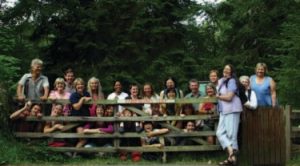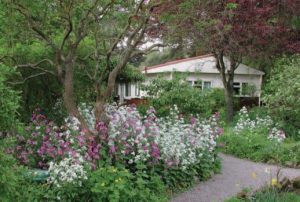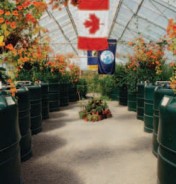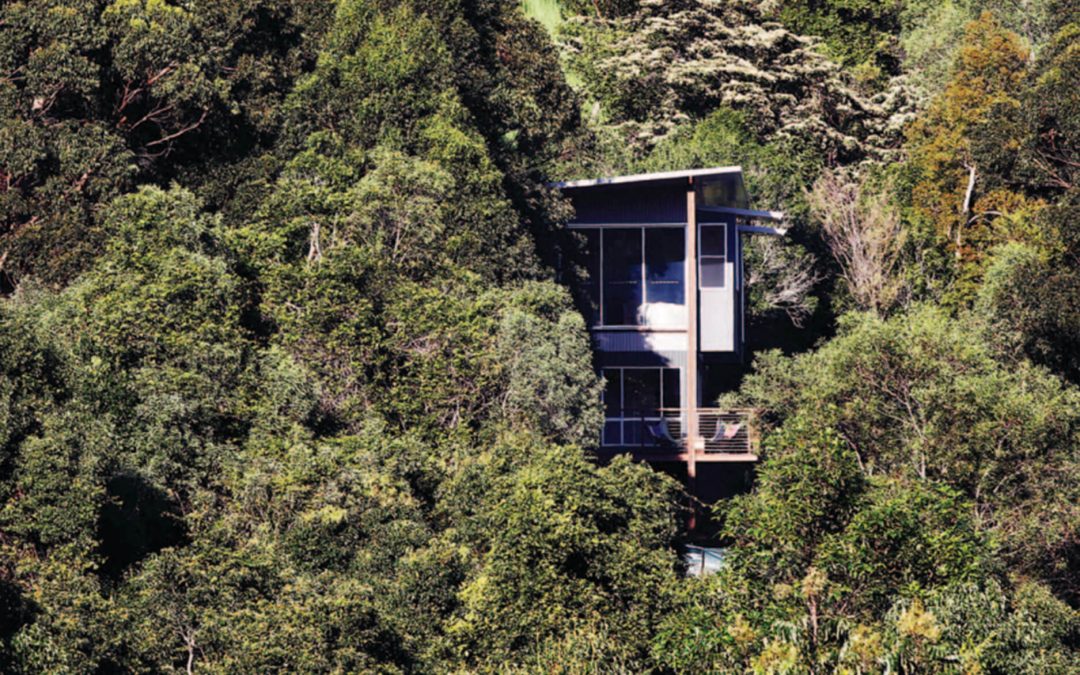The co-housing movement is growing rapidly, particularly in Europe and America.
Most of us are familiar with the concept of the ecovillage, but co-housing
is still relatively rare within Australia. Co-housing residents have intentionally chosen to live within a community and commit to sharing some resources. Traditionally, co-housing was primarily concerned with achieving social objectives, but these days sustainability is emphasised through ecologically sustainable design (ESD). The co-housing movement is growing rapidly, particularly in Europe and America, and there are many exciting examples sprouting like wildflowers around the world.
Co-housing first originated in the mid 1960s when Danish architect Jan Gudmand-Hoyer gathered a group of friends together to discuss housing options with the aim of “a more supportive living environment”. The first two communities, both completed in 1973, were Saettedammen outside Copenhagen and Skråplanet, near Hillerød.
Co-housing developments are considered “intentional communities”, but unlike communes they are not based around any spiritual beliefs and they primarily exist in an urban rather than a rural setting. Contemporary co-housing generally involves properties with individual title for residents but shared utilities like water and electricity and a much greater overlapping of everyday lives than a conventional housing estate.
Literally at the heart of most co-housing developments is the “common house”, which is a multi-purpose room that is large enough for communal meals, meetings, and other group activities. Most co-housing groups have a shared meal at least once a week and this is considered a vital part of community building.
Shared utilities may include a laundry, workshop, garden shed and guest rooms, avoiding repetition of facilities and reducing the footprint of individual dwellings. Separation of cars from residences is considered important, with car spaces located on the edges of the community, pedestrian walkways between houses, and high-use areas such as kitchens facing outwards to increase spontaneous interaction with neighbours.
Co-housing versus ecovillages
While ecovillages and co-housing projects have much in common, there are subtle differences between the two. On the practical side, the red tape of purchasing land and organising initial planning permits for an ecovillage is often done by a developer, whereas in co-housing the residents themselves usually establish their vision and design objectives and then find the land to build their dream. People usually buy into an ecovillage, off the plan or once it has been built, but those in a co-housing project go on a long journey together. And while an ecovillage usually features a common room, the residents have not spent as much time together building the dream so the sense of community is usually not as strong.
Mike Hill, founder of WestWyck ecovillage in inner Melbourne, highlights the difference between the two when he says, “At WestWyck we have taken a deliberate market-exposure approach in the belief that sooner or later a community will form according to who makes a decision to move in.”
While sustainability is usually at the core of both formats, in an ecovillage individual space is valued more, so houses can be quite diverse and spread out. In contrast, the goal of co-housing is to have houses close together to encourage interaction and fairly uniform in style to minimise costs.
Formation and decision making
It can take between four and ten years to set up a co-housing project, from setting up the basic structure to agreeing on a design, getting the plans through local council and finally, construction. People sometimes drop out during the long journey, allowing other people to join. There is rarely a screening process, but potential residents need to understand the basis for the community and the expectations regarding participation before they buy or rent. Homes are strata title so they may be sold on to other interested parties if someone wants to leave, and most communities have a waiting list, making finding new residents fairly easy.
Tony Kidd from Co-housing Australia suggests that the typical co-housing personality is one who wants to have control of their lives. Co-housing can be a way of making interactions easy and providing a decision making model that allows the community to make decisions about what suits their lifestyle. Most intentional communities use consensus decision-making, whereby everyone must agree before they proceed. This can work well for small groups but can be time consuming and participants can suffer from “meeting fatigue” as they thrash out the nuts and bolts from everything to what features they want in their communal areas to whether meat is allowed at communal dinners.
A common adaptation combines consensus decision making with a working group structure. There might be a group for social events, one for gardening, and one for running the common house and those groups have the authority to make smaller decisions for the group as a whole, thereby reducing the number of decisions each individual has to make. Decisions that have a major impact revert back to complete consensus.
Resolving difference of opinion and conflict is an ongoing challenge of co-housing, but one that many members see as a significant benefit. Ian Higginbottom from Cascade Co-housing in Tasmania says: “Community is a crucible for personal growth as you learn to live and work with a range of people and deal with all that comes up in this context. Dealing with conflict and shedding or not keeping ‘baggage’ is necessary for a vibrant and healthy community.”
Europe
Findhorn in Scotland is one of the most famous examples of co-housing in Europe. It is the largest intentional community in the UK, with 61 ecologically sustainable buildings that have the lowest ecological footprint of any community measured in the industrialised world.
Not only has Findhorn published the UK’s first technical guide to ecological housing, Simply Build Green, but the community also adheres to rigorous building codes that are well in excess of the current UK standards. While the homes all adhere to the building codes, the absence of visual guidelines has resulted in a diverse range of design aesthetic throughout the community.
One successful ESD feature at Findhorn has been the Biological Living Machine. It’s an ecologically engineered wastewater treatment system designed to treat sewage from the population of 500 people that results in water pure enough to return to the local water table. Another is the Wind Park, with four Vestas wind turbines generating up to 750kW, ensuring the site is a net exporter of renewable electricity. More information about the remarkable Findhorn community can be found in the documentary The Turning Point (www.theturningpointfilm.com).
An aim of the Munksøgård Ecovillage on the outskirts of Roskilde, Denmark, is to promote diversity of housing size, ownership types and age groups. With 100 row houses accommodating 225 people in total, the group is broken down into five communities that each have their own structure. One community consists of privately owned single-family dwellings; another is a cooperative association where residents own the houses collectively as well as privately owning a share of the dwelling they occupy. The three other communities are made up of rental houses owned by the Roskilde Building Association. One community is designed for young people, another seniors and the final is open to all ages.
Whilst not strictly a co-housing development, One Brighton is one of the first environmentally and socially sustainable “One Planet Communities” in the UK, which adheres to many co-housing ideals. Finished last year, the development comprises 172 apartments ranging from studios to three-bedroom units with a central community space and is recognised by peer review as the UK’s greenest apartment block. The steel frames of the buildings are made from 100 percent recycled material that is considered one of the greenest steels available. Other building materials were selected for their high performance and reduced impacts in sourcing, manufacturing and transportation.
Amongst many environmental initiatives at One Brighton are the on-site communal biomass boiler and photovoltaic panels. These provide more than half the energy requirements of the development, with the remainder bulk purchased as green electricity. To foster a strong sense of community the apartments are located around the central hub and “greenway” that runs throughout, with rooftop allotments for growing fruit and vegetables. The site is located next to Brighton Railway Station and car spaces onsite are limited to those reserved for disabled residents and participants in a car share initiative. Incorporated into the communal space are lockable bicycle storage facilities.
United States
The co-housing movement has been building in the US since architects Kathryn McCamant and Chuck Durrett came back from Denmark full of enthusiasm in the 1980s. The two are credited with coining the term “co-housing”. They have designed many communities and written two handbooks on co-housing, while Durrett is also President of the Co-housing Association of the United States. There are now over 100 co-housing communities throughout the US and a strong online support network.
In upstate New York the Ecovillage at Ithaca contains two co-housing neighbourhoods – Frog and Song – with another in the formation stages, a certified organic vegetable farm, organic berry farm and offices for cottage industries. Over 80 per cent of the 70 hectare site has been dedicated to green space.
Finished in 1997, Frog (First Residents Group) was the first cohousing development completed in New York State and features many ESD features from passive solar design to an innovative communal hot water system. A key to the success of the design lies in the adaptability to connect to future technologies; for instance, dual drain piping was incorporated to allow for a greywater reuse system.
Song (Second Residents Group), finished in 2004, is a tribute to the self-development model of co-housing, allowing individuals to adopt a variety of different “green” building approaches, ranging from drain heat recovery (a heat exchanger to recover energy and reuse heat from drain water) to Durisol foundations (a type of lightweight block made from cement-impregnated wood waste).
There is a growing focus on co-housing targeted at the over-fifty age range, or “seniors” as they are known in the US. With a serious shortage of retirement villages and a plethora of baby boomers reaching retirement, co-housing is becoming a popular option to enable older people to have more control over their circumstances and come together with others who have similar social, environmental and practical needs.
One successful example is Silver Sage Village in Boulder, Colorado, which was completed in 2007. Durrett, in collaboration with Bryan Bowen Architects, designed Silver Sage as a “small scale, participatory community for active adults”. It consists of 16 duplexes and attached houses surrounding a communal house on 0.4 hectares in an urban setting. There is an aspect of spirituality to the Silver Sage community, but it is non-denominational. Outdoor space is prized, with areas for gardening and socialising as well as playing games like bocce. Their common house includes a large kitchen and dining area, some guest rooms, a living area and crafts and performance areas.
While there are many benefits to senior co-housing, it does have a downside. Tony Kidd feels that it is not the ideal community because seniors will need to outsource many tasks such as major gardening projects or anything involving heavy lifting, and the cross-generational benefits of having youngsters and older people living in the same community is lost. It also doesn’t provide long-term care in the way a retirement village does and people may still need to hire a nurse or move out when they need substantial health support.
Australia
Four of the largest co-housing communities in Australia are Cascade Co-housing in South Hobart, Tasmania; its sibling, the Co-housing Cooperative, 300 metres away; Pinakarri Community in Western Australia; and Christie Walk in Adelaide [profiled on p60 of this issue]. A fifth, Eco-housing Heidelberg, is presently under construction in Melbourne.
Cascade Co-housing, established in 1991, is the oldest modern cohousing development in Australia, consisting of 16 households on 0.8 hectares of land. Half of the land is built environment, one-quarter is regenerated bushland and the rest is garden. The development is strata title and managed by a Body Corporate of which all the households are members with a right to vote. This allows the group to use consensus decision making within the constraints of the existing Tasmanian strata title laws. The houses are fairly small, with a two bedroom house averaging 80 square metres. They also have a number of ESD features including eaves for excluding the sun in summer, good insulation and solar hot water. Seven have solar electricity. A shared laundry is used by over half the houses and many don’t have a television, making watching television a communal activity in the common house and saving on electricity and heating in winter. Group meals are available three times a week and the residents have numerous social events, with the entire community attending Christmas and mid-winter celebrations. Ian Higginbottom has lived there for 16 years and says: “Overall, living in co-housing is a huge positive in my experience and, I believe, in the experience of all residents at Cascade Co-housing.”
Conclusion
Co-housing is still relatively new in Australia, but it’s part of a bigger movement addressing major concerns such as the need for a lighter ecological footprint and more sustainable building design, creating high density living that builds community, and addressing the alienation common in suburban housing. Co-housing is a mode of living that has much to offer both residents and the sustainability movement, and we predict it will enjoy substantial growth in coming decades.
Resources
General
Austaralia
- Co-housing Australia: www.communities.org.au
- Cascade Co-housing: www.cascadeco-housing.com
- Co-housing Co-operative: www.cohousingcoop.org
- Moora Moora: www.mooramoora.org.au
- Pinakarri: www.pinakarri.org.au
- Christie Walk: www.urbanecology.org.au/christiewalk
- Urban Coup: www.urbancoup.org
- WestWyck: www.westwyck.com
Europe
- Findhorn (Scotland): www.findhorn.org/aboutus/ecovillage
- Munksøgård: www.munksoegaard.dk
- One Brighton: www.onebrighton.co.uk
- www.co-housing.org.uk/
US
- Ecovillage at Ithaca: http://ecovillageithaca.org/evi/







